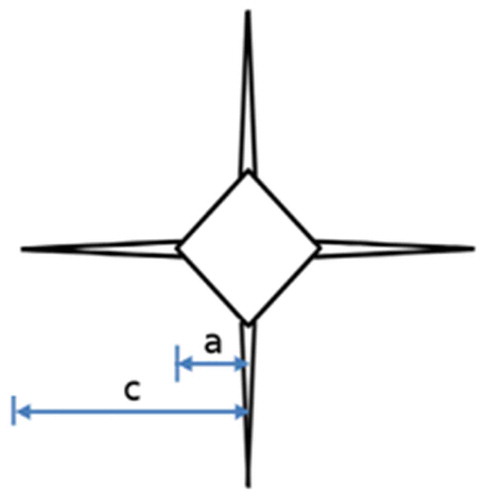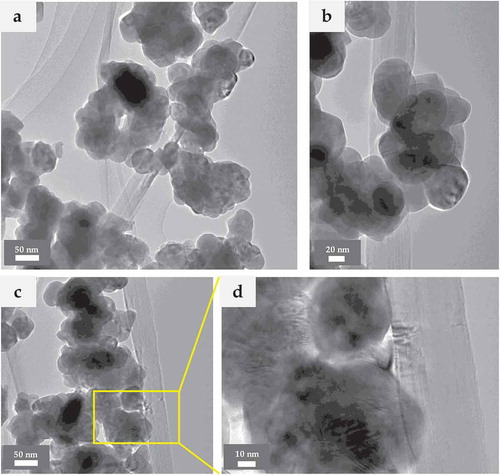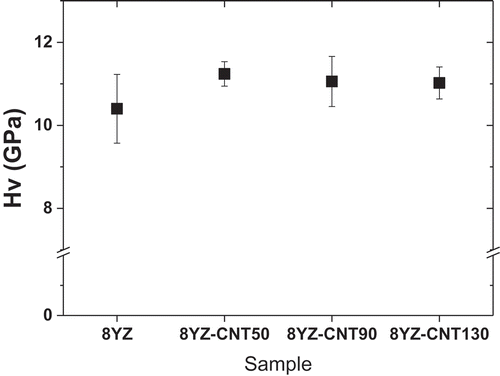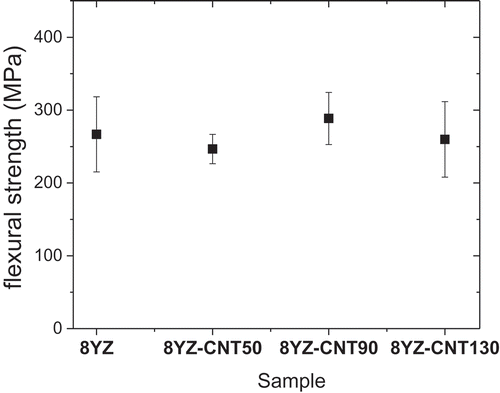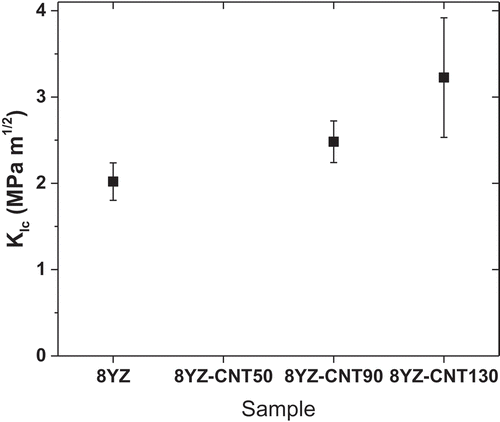 ?Mathematical formulae have been encoded as MathML and are displayed in this HTML version using MathJax in order to improve their display. Uncheck the box to turn MathJax off. This feature requires Javascript. Click on a formula to zoom.
?Mathematical formulae have been encoded as MathML and are displayed in this HTML version using MathJax in order to improve their display. Uncheck the box to turn MathJax off. This feature requires Javascript. Click on a formula to zoom.ABSTRACT
Reinforcement of ceramic composites using carbon nanotubes (CNT) has been extensively studied for materials such as Al2O3, Si3N4 and tetragonal ZrO2. Knowledge concerning CNT composites based on a matrix of cubic zirconia (8YZ) is in short supply, however. This paper presents a study on the addition of 1 wt% CNT to an 8YZ matrix. CNT was functionalized by sulfonitric treatment at three different temperatures: 50, 90 and 130°C. To obtain strong bond between the CNT and the 8YZ particles, the composites were produced by electrostatic heterocoagulation followed by consolidation by spark plasma sintering (SPS). Dense 8YZ-CNT composites were successfully processed by the proposed route. A study of the influence of the surface treatment temperature of CNT on the final properties of ceramics is also presented. CNTs are dispersed uniformly and individually within the 8YZ matrix in 8YZ-CNT90 and 8YZ-CNT130 composites. 8YZ-CNT50 displayed a less uniform CNT distribution and the largest grain size, suggesting that the lowest temperature acid pretreatment is less effective for the subsequent heterocoagulation mixture. The reinforcement of ceramic materials by the addition of 1 wt% CNT was confirmed by an evaluation of fracture toughness.
1. Introduction
There has been a great interest in recent years in the addition of carbon nanotubes (CNT) as a reinforcement for polymer, metal and ceramic composites due to their exceptional properties, including their high aspect ratio and excellent mechanical properties, and their high thermal and electrical conductivities [Citation1–Citation8].
Reinforcement of ceramic composites using CNTs has been extensively studied for materials such as Al2O3, Si3N4 and tetragonal ZrO2 [Citation9–Citation14]. In some of these studies, it has been observed that a higher CNT content does not lead to improvement, since the nanotubes agglomeration due to the van der Waals forces present between them makes dispersion difficult and produces a weak CNT-ceramic interface that restricts the reinforcing capacity of the CNT [Citation9,Citation11,Citation13,Citation15,Citation16]. Estili et al. [Citation17] found that the addition of 3.5% v/v of CNT produces an increment of 67% in the fracture toughness of CNT-alumina composites, remarking that this increase was due to different reinforcement mechanisms such as deflection of cracks, extraction of fibers and cracking of bridges. It is therefore suggested that investigation of the reinforcing capacity and possible reinforcement mechanisms of CNTs in ceramic matrices, requires that CNT be uniformly dispersed in the ceramic matrix, with the lowest possible concentration of agglomerates [Citation18]. This is a fundamental requirement since the uniformity of the CNT dispersed in a ceramic material determines its macroscopic structure, and therefore the final properties of the material. At the same time, the bond between CNT and the ceramic matrix must be strong enough to ensure a good load transfer through the CNT-ceramic matrix interface, and thus to improve the mechanical properties of the ceramic compound.
As for the processing methods employed to obtain CNT-ceramic composites, different methods have been used. One of them is grinding at low energy in a ball mill. This is a simple and inexpensive process but a good dispersion of CNT within the ceramic matrix cannot be obtained. Other authors used high-energy ball milling, since the high power can break CNT agglomerates and improve the dispersion. With this method, CNTs are not agglomerated in the composite matrix, and a good dispersion is achieved. The mechanical properties of these composites after densification are not improved, however possibly due to the low-energy bond in the CNT-ceramic interface. Recently, a ZrO2-multiwall CNT composite was successfully prepared by a simple inverse precipitation method [Citation19].
Among the methods proposed by various authors to introduce CNT into ceramic matrices, electrostatic heterocoagulation appears to be an alternative with minimal complexity, which is scalable and which, most importantly, enables materials with an appreciable homogeneity to be obtained [Citation17]. With this process, CNT does not reagglomerate, even after removal of water or drying, because the nanotubes are anchored and immobilized by the ceramic particles. It is possible to synthesize composite powders in a wide range of CNT concentrations (~2–20 vol%) [Citation20].
This method basically involves producing a mixture of two aqueous suspensions, one with a positive charge and the other with a negative charge, and causing the particles to coagulate by electrostatic attraction ().
Figure 1. Scheme of the electrostatic heterocoagulation method used to disperse the individual CNTs uniformly within the ceramic powder: aqueous suspensions of treated CNT and 8YZ powder; and mixture of the two suspensions during stirring and after 30 min of stirring, when the composite powder heterocoagulated.
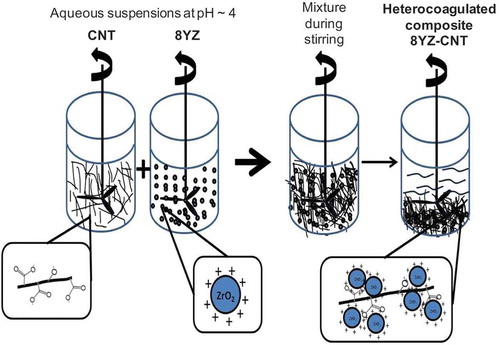
In order to carry out electrostatic heterocoagulation, a well-dispersed aqueous suspension of CNT as well as of zirconia must be obtained. The high aspect ratio of the CNT in conjunction with their high flexibility increases the possibility of their becoming entangled with each other and generating agglomerates. The van der Waals attraction forces between carbon surfaces increase the difficulty of separating these agglomerates further [Citation21]. Surface modification (functionalization) of CNTs using acids (sulfuric and nitric acid, etc.) is an alternative means of achieving a good dispersion of CNTs in the aqueous phase. With this method oxidized groups are formed on the CNT surfaces to produce negative charges and thus allow successful heterocoagulation. There are several variables in the functionalization of CNTs that can affect the result of this surface modification, including the duration of treatment [Citation22], concentration and type of acid [Citation23] and temperature [Citation24].
In two recent articles [Citation24,Citation25], we reported a systematic study of the surface modification of multiwall CNTs by sulfonitric acid exploring both the temperature and time as processing variables. Sulfonitric treatment was selected for the present study due to its known strong oxidizing capabilities, the treatment time was fixed at 20 min, based on bibliographic data, and the variable parameter was the treatment temperature. Taking into account the fact that 110°C is the most reported temperature, we were interested in exploring temperatures above and below this value.
After acid treatment, the CNT surface is negatively charged, and in contact with the 8YZ suspension (positively charged), heterocoagulation is produced and sedimentation occurs. Thus, when the water is removed, the CNTs do not reagglomerate because ceramic nanoparticles are adhered to them [Citation20]. In this way, a good dispersion and strong bonds between the CNT and the ceramic matrix are achieved.
After heterocoagulation, composites must be consolidated in the absence of air. A very efficient technique for this is spark plasma sintering (SPS). This technique essentially consists of the application of uniaxial pressure and a simultaneous high-voltage electric discharge on the powder to be sintered, and the sinterization is achieved mainly through heating from the die and partially through the well-known “Joule effect” between the particles [Citation26,Citation27]. With this method, heating speeds can reach 1000°C/min. By SPS, grain growth is minimized since the dwell times are very short (compared to conventional techniques) [Citation28]. Consequently, with this technique, high-density materials can efficiently be obtained at low temperatures and in short periods of time.
In most of the studies in the bibliography in which CNTs are introduced into a ceramic matrix for reinforcement purposes, the ceramic matrix used is generally alumina and/or tetragonal zirconia. Knowledge concerning the influence of CNT incorporation on 8YZ is scarce. One of the few studies on CNT-cubic zirconia composites is from Mahato et al. [Citation29], in which 6 vol% CNT results in a decrease in hardness but an increment in fracture toughness. Lamnini et al. [Citation30] have recently reported a study on the homogenization and influence of attrition milling on the particle size and distribution of multiwall CNTs in 8YZ powders. Since 8YZ has low fracture toughness compared to 3YZ [Citation31], moreover, it is interesting to study reinforcement through the add-on of carbon fibers to this material. Therefore, a study on the effects of CNT incorporation into a zirconia matrix stabilized with 8 mol% yttria (8YZ) is presented.
In previous research by our group [Citation16], it was found that an increment of over 1 wt% CNT in a tetragonal zirconia (3YZ) matrix did not improve the mechanical behavior with respect to the material without CNT and moreover, that a decrease in these properties was observed. Lamnini et al. [Citation32] found, moreover, that the Vickers hardness and fracture toughness decreased when the CNT content was increased to 5 and 10 wt%. Assuming that the behavior of 8YZ in a composite will be similar to that of 3YZ-CNT composite; therefore, we decided to study the addition of 1 wt% of CNT in an 8YZ matrix.
The characterization of acid-treated CNTs at different temperatures was previously reported [Citation24]. The objective of this study was to develop materials based on 8YZ + 1 wt% CNT by the electrostatic heterocoagulation processing method and to study the influence of the surface treatment temperature of the CNT on the final textural properties of ceramics.
The composites were sintered by SPS at 1300°C. The density and porosity, Vickers hardness and bending strength were evaluated. The fracture surface of composites was also characterized by SEM. We considered that this might shed light on the reinforcement mechanism and help in the design of further strategies for CNT-ceramic composites.
2. Materials and methods
Multiwall CNTs synthesized by catalytic chemical vapor deposition (Hodogaya Chemical Co., Ltd., Tokyo, Japan) were employed. The diameters of the pristine CNTs ranged from 40 to 90 nm, and the average length was 10 µm. Commercially available 8 mol% yttria zirconia (8YZ) nanopowders from Tosoh Corporation (Tokyo, Japan) were used.
In order to determine the pH at which it is possible to carry out the heterocoagulation of 8YZ and CNTs, the zeta potential of each suspension was evaluated with a zeta potential analyzer (Zeta Plus, Brookhaven Instruments Corporation, USA) in the pH range of 3–11.
The surface functionalization of CNTs was achieved by a sulfonitric treatment (previously reported by our group [Citation25]) at three different temperatures: 50, 90 and 130°C. The treated CNTs were washed with distilled water until the supernatant liquid reached a constant pH. An aqueous suspension of zirconia was prepared and ball-milled for 7 h. After adjustment of the pH by HCl, the zirconia suspension was gently mixed with the CNT suspension for 30 min to obtain 8YZ+1wt% CNT composites. After this time, the mixture was left to stand until total sedimentation of the composite, and the remaining water was completely transparent. The heterocoagulated 8YZ-CNT powders were dried at 280°C for 4 days. These powders were characterized by transmission electron microscopy (TEM; Zeiss EM109 Turbo). The samples were labeled 8YZ-CNT50, 8YZ-CNT90 and 8YZ-CNT130 (8YZ mixed with CNT treated at 50, 90 and 130°C, respectively).
The 8YZ-CNT composite powders were consolidated by SPS (SPS, Dr. Sinter, Sumitomo, Kawasaki, Japan) in a graphite die with an inner diameter of 25 mm at a temperature of 1300°C under pressure of 75 MPa for 10 min [Citation33,Citation34]. The density of the sintered composites was determined by the Archimedes method. The microstructure analysis was performed by scanning electron microscopy (SEM; FEI Quanta 200). The Vickers hardness (Hv) was measured by the Vickers indentation method (Buehler, Identamet 1100); a 0.5 kg load was applied to a polished surface for 15 s. At least six indents were made on each sample, and the average value was recorded. The flexural strength was measured with a universal testing machine (INSTRON 4483). The fracture toughness (KIC) was calculated, when possible, by the Pamlqvist method [Citation35], using the formula proposed by Lankford [Citation36]:
where KIc is fracture toughness, H is Vickers hardness, E is the Young’s modulus (210 GPa for zirconia [Citation37]), Φ is the constraint factor (~3), and c and a are as defined in .
3. Results and discussion
3.1. Heterocoagulation of zirconia-CNT composite powder
Electrostatic heterocoagulation of CNT-8YZ composites consists of the decoration of individual CNTs with zirconia particles. This process involves gentle incorporation of a stable CNT suspension into a well-dispersed zirconia suspension. It is, therefore, necessary to know the most favorable pH for the greatest difference in surface charges between the 8YZ suspension and the CNT suspension to result. The zeta potential of these suspensions was measured (). It was found that the maximum charge difference is given at pH ~ 4.5, where the zeta potential of the 8YZ suspension is ~ 30 mV and, conversely, the value for the CNT suspension is ~ −25 mV. At this pH of 4.5, there is an attractive driving force between the positively charged zirconia particles and the negatively charged CNTs, which results in a strong interfacial bonding [Citation10].
Figure 3. Zeta potentials of treated CNTs (at three temperatures: 50, 90 and 130°C) and 8YZ suspensions at various pH values. The dotted outline zone corresponds to the possible working pH range (pH ~ 4.5).
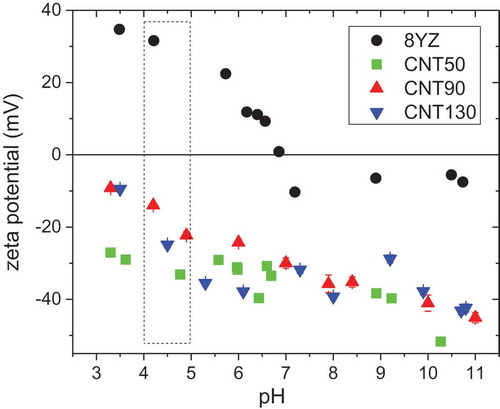
–d) show TEM images of 8YZ-CNT130 heterocoagulated powder at different magnifications. It can be observed (, )) that zirconia particles (rounded dark particles) are arranged around CNTs, indicating that heterocoagulation is a successful method for fabricating zirconia-CNT composites. The close contact between the zirconia particles and CNTs can provide effective load transferal from the matrix to the CNTs after consolidation and an increase in density [Citation17].
It can be observed, moreover, that zirconia particles are preferably located in the defect region of the tubes (, )). During the functionalization of CNTs by acid treatment, oxidized species formed on the CNT surface. Zhou et al. [Citation22] showed that defects are preferentially generated on intrinsic structural defect sites (such as vacancies, 5–7 atomic defects in the hexagonal C-C network, dangling bonds) of pure CNT outer walls. Since the chemical bonds produced by functionalization are located on the CNT defect sites, zirconia particles can be anchored there. Cho et al. [Citation38] reported that some types of defects could effectively increase the load-bearing capacity of CNTs in CNT-metal composites. It is expected that the same will occur in such other cases as for ceramic composites [Citation22].
3.2. Consolidated zirconia-CNT composites obtained by spark plasma sintering (SPS)
Fully dense 8YZ and 8YZ-CNT materials were obtained by SPS at 1300°C. SPS technology is an efficient method of obtaining dense materials quickly and at relatively low temperatures. Archimedes immersion test gave negligible porosity values (P < 0.1 vol%) for all the samples.
SEM images of sintered composite fracture surfaces (8YZ-CNT50, 8YZ-CNT90 and 8YZ-CNT130) are presented in –f), respectively. CNTs are uniformly and individually dispersed within the 8YZ matrix in 8YZ-CNT90 and 8YZ-CNT130 composites (, ). Some CNTs are located on the grain boundaries of the 8YZ matrix as well as across the 8YZ matrix. CNTs in sintered 8YZ-CNT50 composite are located on preferential zones, and their grain size is greater than those in the other samples ()). This was not observed in the 8YZ-CNT90 and 8YZ-CNT130 materials (, ), respectively) possibly due to the fact that acidic pretreatment at 50ºC is less effective for these mixtures. This observation might be explained by lower functionalization and defect formation during this pretreatment [Citation24,Citation25]. On the other hand, the other two pretreatments (at higher temperatures: 90ºC and 130ºC) displayed better homogenization during the heterocoagulation processes. In ), it is observed that the grain size is smaller in areas where CNTs are located than in areas with no CNTs. Thus, nonuniform CNT dispersion exerts effects on the grain size and grain distribution in the composite.
Figure 5. SEM micrographs of the fracture surfaces of SPS-consolidated composites at low and high magnifications: a-b) 8YZ-CNT50, c-d) 8YZ-CNT90 and e-f) 8YZ-CNT130.
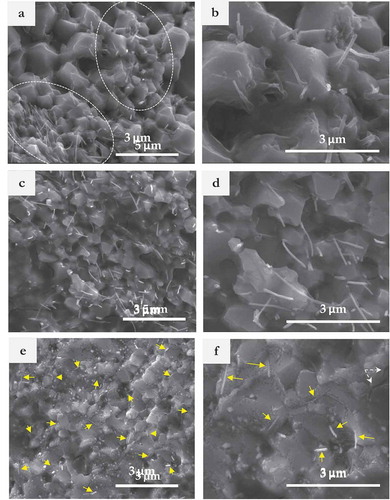
The fracture mode is mainly intergranular. ) shows some footprints (indicated by dotted arrows) in a fracture surface corresponding to CNTs that have been removed from the matrix. The removal of CNTs from the matrix requires that work be done to overcome the interfacial friction, a process that contributes to effectively dissipating the fracture energy and, in so doing, reinforcing the material. According to Estili et al. [Citation10], this mechanism is called pullout (of CNT). The close contact between the ceramic material and the CNTs achieved by the heterocoagulation process in the consolidated materials contributes to improving the reinforcement, since it is necessary to apply greater energy for the pullout of CNTs from the matrix.
The energy required to pull out nanotubes is related to their length: the longer they are, the greater the sliding friction, which is to say, the more energy dissipated due to the presence of CNTs, thus making long CNTs more efficient for reinforcement. In addition, CNTs that are located perpendicular to the crack plane are more effective in supporting the bridging mechanism, which is considered to be one of the reinforcement mechanisms in ceramic composites [Citation39]. CNTs that are relatively parallel to the crack planes may not contribute effectively to the bridging process, but only to the deviation of cracks. Although, some of these CNTs can nevertheless deform and generate bridging; in such cases the reinforcement is less effective [Citation10].
shows the Vickers hardness (Hv) of 8YZ and the composites. The values are almost the same as in the case of the materials that contain CNTs (~ 11 GPa), and this value is slightly greater than that for monolithic materials (~ 10.5 GPa). When the uncertainty of the measurements is taken into account, however there is no actual increment in the value for Hv. Similar results were found using different matrices such as alumina [Citation40,Citation41] and tetragonal zirconia (3YZ) [Citation42–Citation44]. The CNT reinforcement mechanism can be disregarded for these composites.
presents the flexural strength of 8YZ and 8YZ-CNT composites. There is significant uncertainty inherent to the measurement method. Both 8YZ and 8YZ-CNT composites display flexural strengths similar, although there is a minimum average flexural strength value for 8YZ-CNT50. Stawarczyk et al. [Citation45] found that increases in grain size decrease the flexural strength of zirconia materials. ) shows that the grain size of 8YZ-CNT50 is larger than that of 8YZ-CNT90 and 8YZ-CNT130. Thus, this could be related to the flexural modulus of 8YZ-CNT50 composites, which was found to be the lowest among the materials studied. This is related to the lower homogeneity grade of the mixture during the heterocoagulation, moreover, as can be observed in ).
According to Zhou [Citation22], a sufficient number of functional groups should be induced at the CNT surface to obtaining a homogeneous dispersion of CNTs, and an appropriate number of defects generated on the outer walls of the CNTs would improve the interfacial bonding between these and the ceramic particles, thus enhancing the final load-bearing capacity of CNTs in the final composite. If the number of defects generated during the acid treatment of the CNT surface is insufficient, the CNT-matrix bonding will not be sufficiently strong. This may be associated with the behavior of the CNT50 sample. Although the zeta potential showed that the CNT surface was negatively charged, it is possible that the number of oxidized species in CNT50 was very small due to the low-temperature treatment. This leads to deficient dispersion and, therefore, to weak connections between the CNTs and zirconia particles. Consequently, the composite properties such as flexural strength deteriorate. The nonuniform CNT dispersion in the matrix could affect the homogeneity during the consolidation by SPS, moreover, promoting grain growth [Citation46].
Zhou et al. reported [Citation22], that increasing the functionalization time increases the deterioration of the CNT walls. Analogously to our case, the higher the temperature, the greater the damage to the CNTs, and this produces zones of minimum mechanical strength in the composite. It can be inferred from this that the number of defects is greater at high temperatures such as 130°C, which leads to deterioration of the final composite’s mechanical properties, as seen in , where the flexural strength decreases slightly with increasing the treatment temperature from 90 to 130°C.
Resistance to crack propagation was evaluated by measuring the indentation fracture toughness (KIc). In the 8YZ-CNT50 sample, it was not possible to measure KIc since clear Palmqvist type cracks were not formed at low loads and the material showed some spalling at high loads. presents the KIc of 8YZ, 8YZ-CNT90 and 8YZ-CNT130. Regardless of the uncertainty it is apparent that fracture toughness was increased in the composites with CNT. Thus, the incorporation of pre-treatment CNT at 90 and 130°C into a cubic zirconia matrix enhances resistance to crack propagation. This is a novel finding in terms of reinforcement by adding CNT to a matrix of cubic zirconia. These results encourage use of the proposed processing route for preparation of ceramic composites.
4. Conclusions
Dense, homogeneous 8YZ-CNT composites with a content of 1 wt% CNT previously treated at three different temperatures, 50, 90 and 130°C, were successfully processed by electrostatic heterocoagulation. Surface modification by acid pretreatment was studied.
This process was found to be an effective method of anchoring CNTs in an 8YZ matrix. Zirconia grains were located in nanotube defects produced by the acid treatment, as shown by TEM images of the heterocoagulated nanopowder.
The SPS-sintered materials 8YZ and its composites (8YZ-CNT50, 8YZ-CNT90 and 8YZ-CNT130) displayed complete densification (with negligible porosity). CNTs were dispersed uniformly and individually throughout the 8YZ matrix in 8YZ-CNT90 and 8YZ-CNT130 composites, while the distribution was less homogeneous in 8YZ-CNT50, suggesting that the lowest temperature acid pretreatment was less effective for the subsequent heterocoagulation of the mixture. The grain size in 8YZ-CNT50 is larger than that in the other samples. This suggests that a better mixture restricts grain growth during SPS treatment. It can also be related to the fact that this material presented the lowest flexural modulus. The decrease in the value for this property in the 8YZ-CNT130 composite could be related to the temperature of the pretreatment carried out on the CNT: the higher the temperature, the greater the damage and, consequently, the weaker the anchoring of the CNT in the matrix.
The Vickers hardness was slightly higher for the 8YZ-CNT composite materials. The incorporation of pre-treated CNT at 90 and 130°C in a cubic zirconia matrix enhanced the resistance to crack propagation, as evidenced by the higher (~50% for 8YZ-CNT130) evaluated fracture toughness.
Acknowledgments
The authors would like to thank CONICET (Consejo Nacional de Investigaciones Científicas y Tecnológicas) and ANPCyT (Agencia Nacional de Promoción Científica y Tecnológica) for their financial support. We would also like to thank NIMS (National Institute for Materials Science) and its staff for receiving us and providing all the facilities for the conduct of this study. S. Gómez is grateful for the support provided by the National Institute for Materials Science through the NIMS Internship Program.
Disclosure statement
No potential conflict of interest was reported by the authors.
Additional information
Funding
References
- Curtin WA, Sheldon BW. CNT-reinforced ceramics and metals. Mater Today. 2004;7:44–49.
- Duszová A, Dusza J, Tomášek K, et al. Zirconia/carbon nanofiber composite. Scr Mater. 2008;58:520–523.
- Mohapatra P, Rawat S, Mahato N, et al. Restriction of phase transformation in carbon nanotube-reinforced yttria-stabilized zirconia. Metall Mater Trans A. 2015;46:2965–2974.
- Peigney A, Laurent C, Rousset A. Synthesis and characterization of alumina matrix nanocomposites containing carbon nanotubes. Key Eng Mater. 1997;132–136:743–746.
- Rishabh A, Joshi MR, Balani K. Fractal model for estimating fracture toughness of carbon nanotube reinforced aluminum oxide. J Appl Phys. 2010;107:123532.
- Treacy MMJ, Ebbesen TW, Gibson JM. Exceptionally high Young’s modulus observed for individual carbon nanotubes. Nature. 1996;381:678–680.
- Xia Z, Riester L, Curtin WA, et al. Direct observation of toughening mechanisms in carbon nanotube ceramic matrix composites. Acta Materialia. 2004;52:931–944.
- Zhu Y-F, Shi L, Liang J, et al. Synthesis of zirconia nanoparticles on carbon nanotubes and their potential for enhancing the fracture toughness of alumina ceramics. Compos Part B Eng. 2008;39:1136–1141.
- Cho J, Boccaccini AR, Shaffer MSP. Ceramic matrix composites containing carbon nanotubes. J Mater Sci. 2009;44:1934–1951.
- Estili M, Kawasaki A, Sakamoto H, et al. The homogeneous dispersion of surfactantless, slightly disordered, crystalline, multiwalled carbon nanotubes in α-alumina ceramics for structural reinforcement. Acta Materialia. 2008;56:4070–4079.
- Estili M, Sakka Y, Kawasaki A. Unprecedented simultaneous enhancement in strain tolerance, toughness and strength of Al2O3 ceramic by multiwall-type failure of a high loading of carbon nanotubes. Nanotechnology. 2013;24: 155702. (9pp).
- Melk L, Roa Rovira JJ, García-Marro F, et al. Nanoindentation and fracture toughness of nanostructured zirconia/multi-walled carbon nanotube composites. Ceram Int. 2015;41:2453–2461.
- Zapata-Solvas E, Gómez-García D, Domínguez-Rodríguez A. Towards physical properties tailoring of carbon nanotubes-reinforced ceramic matrix composites. J Eur Ceram Soc. 2012;32:3001–3020.
- Matsuoka M, Tatami J, Wakihara T, et al. Improvement of strength of carbon nanotube-dispersed Si3N4 ceramics by bead milling and adding lower-temperature sintering aids. J Asian Ceram Soc. 2014;2:199–203.
- Kasperski A, Weibel A, Estournès C, et al. Preparation-microstructure-property relationships in double-walled carbon nanotubes/alumina composites. Carbon. 2013;53:62–72.
- Suárez G, Jang B-K, Aglietti EF, et al. Fabrication of dense ZrO2/CNT composites: influence of bead-milling treatment. Metall Mat Trans A. 2013;44:4374–4381.
- Estili M, Kawasaki A. An approach to mass-producing individually alumina-decorated multi-walled carbon nanotubes with optimized and controlled compositions. Scr Mater. 2008;58:906–909.
- Kumar PS, Smart DSR, Alexis SJ. Corrosion behaviour of aluminium metal matrix reinforced with multi-wall carbon nanotube. J Asian Ceram Soc. 2017;5:71–75.
- Ghahfarokhi SS, Mamoory RS, Kalashami AG. Inverse precipitation synthesis of ZrO2 nanopowder and in-situ coating on MWCNTs. Ceram Int. 2018;44:13556–13564.
- Estili M, Sakka Y. Recent advances in understanding the reinforcing ability and mechanism of carbon nanotubes in ceramic matrix composites. Sci Technol Adv Mater. 2014;15:064902.
- Inam F. Development of Ceramic – Carbon Nanotube (CNT) nanocomposites. London (UK): School of Engineering and Materials Science Queen Mary, University of London; 2009.
- Zhou W, Sasaki S, Kawasaki A. Effective control of nanodefects in multiwalled carbon nanotubes by acid treatment. Carbon. 2014;78:121–129.
- Zhang J, Zou H, Qing Q, et al. Effect of chemical oxidation on the structure of single-walled carbon nanotubes. J Phys Chem B. 2003;107:3712–3718.
- Gómez S, Rendtorff NM, Aglietti EF, et al. Intensity of sulfonitric treatment on multiwall carbon nanotubes. Chem Phys Lett. 2017;689:135–141.
- Gómez S, Rendtorff NM, Aglietti EF, et al. Surface modification of multiwall carbon nanotubes by sulfonitric treatment. Appl Surf Sci. 2016;379:264–269.
- Tiwari D, Basu B, Biswas K. Simulation of thermal and electric field evolution during spark plasma sintering. Ceram Int. 2009;35:699–708.
- Grasso S, Sakka Y, Maizza G. Electric current activated/assisted sintering (ECAS): A review of patents 1906-2008. Sci Technol Adv Mater. 2009;10:053001.
- Bruni YL, Compositos del sistema ZrO2-CaO-Al2O3 obtenidos por reacción-sinterización de zirconia y cemento de alta alúmina [Tesis], Facultad de Ciencias Exactas; 2014.
- Mahato N, Nisar A, Mohapatra P, et al. Effect of far-field stresses and residual stresses incorporation in predicting fracture toughness of carbon nanotube reinforced yttria stabilized zirconia. J Appl Phys. 2017;122:145104.
- Lamnini S, Fogarassy Z, Horváth ZE, et al., The role of the attrition milling on the grain size and distribution of the carbon nanotubes in YSZ powders. Boletín de la Sociedad Española de Cerámica y Vidrio; 2018.
- Gómez S, Suarez G, Rendtorff N, et al. Relation between mechanical and textural properties of dense materials of tetragonal and cubic zirconia. Sci Sintering. 2016;48:119–130.
- Lamnini S, Károly Z, Bódis E, et al. Influence of structure on the hardness and the toughening mechanism of the sintered 8YSZ/MWCNTs composites. Ceram Int. 2019;45:5058–5065.
- Rendtorff NM, Grasso S, Hu C, et al. Dense zircon (ZrSiO 4) ceramics by high energy ball milling and spark plasma sintering. Ceram Int. 2012;38:1793–1799.
- Rendtorff NM, Grasso S, Hu C, et al. Zircon-zirconia (ZrSiO 4-ZrO 2) dense ceramic composites by spark plasma sintering. J Eur Ceram Soc. 2012;32:787–793.
- Moreira Toja RJ, Rendtorff NM, Aglietti EF, et al. Influence of the porosity caused by incomplete sintering on the mechanical behaviour of lanthanum silicate oxyapatite. Ceram Int. 2018;44:14348–14354.
- Lankford J. Indentation microfracture in the Palmqvist crack regime: implications for fracture toughness evaluation by the indentation method. J Mater Sci Lett. 1982;1:493–495.
- Živcová Z, Černý M, Pabst W, et al. Elastic properties of porous oxide ceramics prepared using starch as a pore-forming agent. J Eur Ceram Soc. 2009;29:2765–2771.
- Cho S, Kikuchi K, Miyazaki T, et al. Epitaxial growth of chromium carbide nanostructures on multiwalled carbon nanotubes (MWCNTs) in MWCNT–copper composites. Acta Materialia . 2013;61:708–716.
- Curtin W. Stress-strain response of brittle matrix composites. In: Book: Comprehensive Composite Materials. 2000. p.47–76.
- Bocanegra-Bernal MH, Dominguez-Rios C, Echeberria J, et al. Spark plasma sintering of multi-, single/double- and single-walled carbon nanotube-reinforced alumina composites: is it justifiable the effort to reinforce them? Ceram Int. 2016;42:2054–2062.
- Yamamoto G, Shirasu K, Hashida T, et al. Nanotube fracture during the failure of carbon nanotube/alumina composites. Carbon. 2011;49:3709–3716.
- Duszová A, Dusza J, Tomášek K, et al. Microstructure and properties of carbon nanotube/zirconia composite. J Eur Ceram Soc. 2008;28:1023–1027.
- Mazaheri M, Mari D, Schaller R, et al. Processing of yttria stabilized zirconia reinforced with multi-walled carbon nanotubes with attractive mechanical properties. J Eur Ceram Soc. 2011;31:2691–2698.
- Dusza J, Blugan G, Morgiel J, et al. Hot pressed and spark plasma sintered zirconia/carbon nanofiber composites. J Eur Ceram Soc. 2009;29:3177–3184.
- Stawarczyk B, Özcan M, Hallmann L, et al. The effect of zirconia sintering temperature on flexural strength, grain size, and contrast ratio. Clin Oral Invest. 2013;17:269–274.
- Inam F, Yan H, Peijs T, et al. The sintering and grain growth behaviour of ceramic–carbon nanotube nanocomposites. Compos Sci Technol. 2010;70:947–952.

